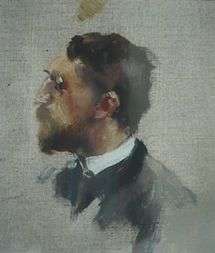Adolf Hölzel

Adolf Richard Hölzel (13 May 1853, Olmütz - 17 October 1934, Stuttgart) was a German painter. He began as a Realist, but later became an early promoter of various Modern styles, including Abstractionism.
Biography
His father was the publisher, Eduard Hölzel. In 1868, he completed a three-year apprenticeship as a typesetter at the map publishing firm of F.A.Perthes in Gotha. Three years later, he and his family moved to Vienna where, the following year he enrolled at the Academy of Fine Arts, moving to the Academy of Fine Arts, Munich, in 1876, where he studied with Wilhelm von Diez.[1]

After completing his studies, he was married and divided his time between Munich and Rothenburg ob der Tauber. In Munich, he became acquainted with Fritz von Uhde, who introduced him to Impressionism. Together with Von Uhde, Ludwig Dill and Arthur Langhammer (1854-1901), he helped create the "Dachauer Malschule", which later became the famous artists' colony at Dachau. He lived there from 1888 to 1905 and his novel teaching methods drew students from all over Europe. In 1904, he participated in the first exhibition of the Deutscher Künstlerbund.
Already during his time in Dachau his work began moving toward abstraction, reflecting his interest in such principles as the golden section and Goethe's Theory of Colors. After studying the color theories of Wilhelm von Bezold, he developed his own color theory, based on a circle with "diatonic" and "chromatic" values (terms taken from music).[2] He was involved in creating the Munich Secession and the Vienna Secession. His influential essay "Über Formen und Massenvertheilung" (On Shapes and Mass Distribution), was published in Ver Sacrum. After leaving Dachau, he still returned in the summer months to give private lessons.
In 1905, he was appointed to replace Leopold von Kalckreuth at the State Academy of Fine Arts in Stuttgart and received commissions on religious themes from the Deutscher Werkbund. Despite abandoning Realism, he still felt that his paintings contained a strong element of religion. Among his students the so-called "Hölzel circle" developed, including Oskar Schlemmer, Willi Baumeister, Max Ackermann, Alf Bayrle and Johannes Itten. He was constantly promoting exhibitions of Expressionist art and established a special painting school for women.
Tired of the continuous opposition from his colleagues, he retired in 1919, but continued to give private lessons and work as a freelance painter. He died in obscurity in 1934. His personal papers have been preserved at the Staatsgalerie Stuttgart. In 2005, the non-profit "Adolf Hölzel-Stiftung" was created to preserve and promote his works.
Selected paintings
 Composition
Composition Journey
Journey Figures in a Landscape
Figures in a Landscape Composition in Red
Composition in Red Adoration
Adoration
References
- ↑ Auszug aus dem Matrikelbuch 1841–1884, AdBK München
- ↑ Johannes Pawlik: Theorie der Farbe. DuMont Verlag, Cologne 1990, ISBN 3-7701-0510-9
- Wolfgang Venzmer (1972), "Hölzel, Adolf", Neue Deutsche Biographie (NDB) (in German), 9, Berlin: Duncker & Humblot, pp. 339–340; (full text online)
Further reading
- Marion Ackermann, Gerhard Leistner, Daniel Spanke (Eds.): Kaleidoskop. Hoelzel in der Avantgarde. Kehrer Verlag, Heidelberg 2009, ISBN 978-3-86828-089-0.
- Dörthe Jakobs, Viola Lang: "Das einzige Wandbild von Adolf Hölzel. Der Kruzifixus in der evangelischen Pauluskirche in Ulm." In: Denkmalpflege in Baden-Württemberg. #40, Vol.1 pgs. 45–50 (Online)
- Oliver Jehle: "Über künstlerische Religion. Adolf Hölzels Malerei als spekulative Theologie." In: Christoph Dohmen (Ed.): Religion als Bild – Bild als Religion. Schnell & Steiner, Regensburg 2011 ISBN 978-3-7954-2546-3
- Alexander Klee: Adolf Hölzel und die Wiener Secession. Prestel Verlag, München 2006. ISBN 3-7913-3594-4.
- Karin von Maur: Der verkannte Revolutionär: Adolf Hölzel. Werk und Wirkung. Hohenheim Verlag, Stuttgart 2003 ISBN 3-89850-112-4.
- Christoph Wagner, Gerhard Leistner (Eds.): Vision Farbe. Adolf Hölzel und die Moderne. Wilhelm Fink, Paderborn 2015, ISBN 978-3-7705-5258-0.
External links
| Wikimedia Commons has media related to Adolf Hölzel. |
- Adolf-Hölzel-Stiftung, website home page
- Literature by and about Adolf Hölzel in the German National Library catalogue
- ArtNet: More works by Hölzel.
- "Works by Adolf Hölzel". Zeno.org (in German).
- Adolf Hölzel in the Staatsgalerie Stuttgart